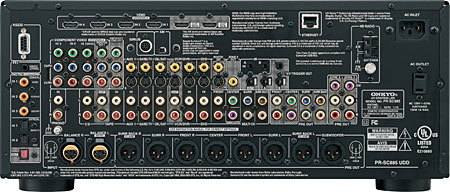Onkyo Professional PR-SC885 Preamp/Processor Setup & Tests
The Onkyo Pro provides four HDMI inputs, and I put each one to good use by connecting a TiVo Series3, a Toshiba HD-A35 HD DVD player, a Sony PS3, and an Oppo DV-970HD DVD player. I also connected a Microsoft Xbox 360 to one of the three component inputs, which the pre/pro transcoded to HDMI.
The HDMI output does not provide enough power for my PureLink HDMI cable, requiring me to use its external power supply. Other AVRs have had a similar problem, but it is of little consequence since PureLink includes an external power supply with the cable for just such a circumstance. In any event, I doubt it will be a problem with a good HDMI cable under 10 meters in length.

Having used Audyssey MultEQ calibration in other devices, I didn't hesitate to make this the first priority when starting my critical evaluation. The calibration process can measure up to eight different locations in your room, but I only measured my four available seating locations. To initiate calibration, connect the supplied microphone to the mic input and the setup program automatically runs.
Measuring four positions and calculating the corrections took about 25 minutes. Once completed, I checked the distance calculations, and the measurements were recorded with an accuracy of 0.2 foot. The distance measurements were spot on and no changes were required. The same couldn't be said for the crossover—my front speakers were set to 40Hz, my side surrounds to 120Hz, and my two rear speakers to 150Hz. All of my speakers are THX-certified, so I manually changed the crossovers to 80Hz per THX's recommendation.
 Using a RadioShack SPL meter, the speaker levels were accurate with the exception of the surround speakers, which were a little hot and needed to be turned down by 1dB. Comparing the audio with Audyssey on and off, I preferred it on, which gave the audio a fuller sound with greater depth in the soundstage. If you don't like the results of Audyssey, the Onkyo Pro lets you manually adjust the tone of your speakers with a 15-band graphic equalizer. In addition, you can hire a certified Audyssey Professional Installer, who can perform the MultEQ Pro equalization from a PC laptop running the MultEQ Pro software. To find an installer in your area, check out Audyssey's website.
Using a RadioShack SPL meter, the speaker levels were accurate with the exception of the surround speakers, which were a little hot and needed to be turned down by 1dB. Comparing the audio with Audyssey on and off, I preferred it on, which gave the audio a fuller sound with greater depth in the soundstage. If you don't like the results of Audyssey, the Onkyo Pro lets you manually adjust the tone of your speakers with a 15-band graphic equalizer. In addition, you can hire a certified Audyssey Professional Installer, who can perform the MultEQ Pro equalization from a PC laptop running the MultEQ Pro software. To find an installer in your area, check out Audyssey's website.
Unlike many AVRs, HDMI sources can be processed by the HQV chipset. I utilized the 480i output from my Oppo DV-970HD over HDMI and had the Onkyo Pro upconvert the signal to 1080p to see how well the pre/pro did at upconverting interlaced signals from DVD. It was perfect. Whether it was the jaggies tests from the HQV Benchmark DVD or real-world material from chapter 12 of Gladiator, the deinterlacing performance was spectacular.
To see how well it upconverts 1080i signals to 1080p, I used chapter 8 of Mission Impossible: III on HD DVD. The staircase sequence looked nearly perfect, with only a hint of moiré that was barely perceptible. Looking at the TLV-200 pattern from the Avia test DVD, the 6.75MHz circle in the lower-right corner looked as it should, and the pre/pro was not clipping any of the highest frequencies.
Although there is no mention in the manual of this, picture controls are available for the HDMI output. Adjustments can be made to brightness, contrast, hue, saturation, edge enhancement, mosquito noise, random noise, and block noise. To access these controls, hold the Display button on the remote for five seconds, and they appear on the front-panel display of the pre/pro.
I applaud the inclusion of these adjustments, but I do have one criticism. They are global, not input-specific, so if the outputs from three of your source components match but the brightness from the fourth needs a little boost, you have to manually change this every time. With only one HDMI cable going to the display, this would be a great feature in the pursuit of video perfection if the controls could be applied to each input individually.
There were two other flaws in the upconversion. First, it didn't handle 4:3 material correctly. Instead of showing the proper aspect ratio, it applied "stretch-o-vision," which expands the video to fill the full 16:9 screen. Second, when converting standard-definition signals to 720p/1080i/1080p, the color space was incorrect. I can't tell if it's converting Rec. 601 to 709 when it's not supposed to, or it's not doing that conversion when it is supposed to, or what. All I know is, with the processing turned on, the colors look slightly inaccurate when watching upconverted standard-def; when the processing is turned off, the colors look correct. I have spoken with Onkyo regarding this issue, and they are looking into it.












































